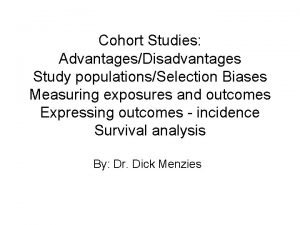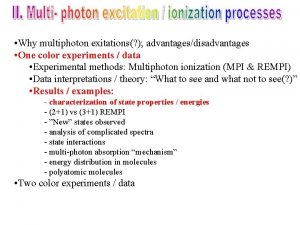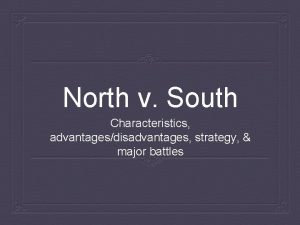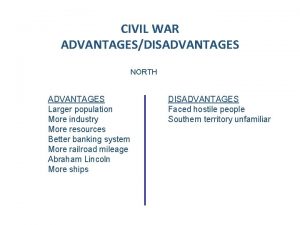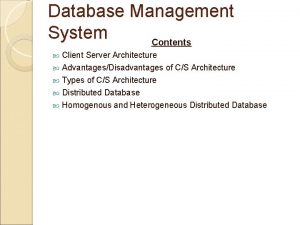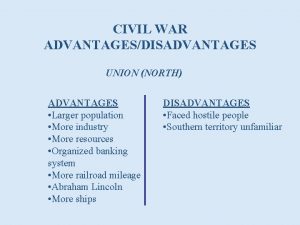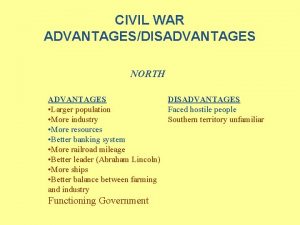Review What are the advantagesdisadvantages of pages versus




















- Slides: 20

Review • What are the advantages/disadvantages of pages versus segments? 9/15/2021 CSE 378 Virtual Mem. Impl. 1

Review • What are the advantages/disadvantages of pages versus segments? • What information does a page table entry (PTE) contain? Be complete. 9/15/2021 CSE 378 Virtual Mem. Impl. 2

Review • What are the advantages/disadvantages of pages versus segments? • What information does a page table entry (PTE) contain? Be complete. • Every address, virtual or physical, is composed of two parts; what are they? 9/15/2021 CSE 378 Virtual Mem. Impl. 3

Review • What are the advantages/disadvantages of pages versus segments? • What information does a page table entry (PTE) contain? Be complete. • Every address, virtual or physical, is composed of two parts; what are they? • In caching terms, what is the main memory? 9/15/2021 CSE 378 Virtual Mem. Impl. 4

Review • What are the advantages/disadvantages of pages versus segments? • What information does a page table entry (PTE) contain? Be complete. • Every address, virtual or physical, is composed of two parts; what are they? • In caching terms, what is the main memory? • On a L 1 cache miss, the processor stalls, but on a page fault (page miss) it switches context. Why? 9/15/2021 CSE 378 Virtual Mem. Impl. 5

Review • What are the advantages/disadvantages of pages versus segments? • What information does a page table entry (PTE) contain? Be complete. • Every address, virtual or physical, is composed of two parts; what are they? • In caching terms, what is the main memory? • On a L 1 cache miss, the processor stalls, but on a page fault (page miss) it switches context. Why? • Paging, VM, demand loading are interacting ideas; explain each. 9/15/2021 CSE 378 Virtual Mem. Impl. 6

Translation Buffers (TLBs) • To perform virtual to physical address translation we need to look-up a page table entry • Since the page table is in memory, need to access memory – Much too time consuming; 50 cycles or more per memory reference • Hence we need to cache the page tables • For that purpose special caches named translation buffers are part of the memory system – Also named Translation Lookaside Buffers (TLBs) 9/15/2021 CSE 378 Virtual Mem. Impl. 7

TLB organization • TLB organized as caches • Therefore for each entry in the TLB we’ll have – a tag to check that it is the right entry – data which instead of being the contents of memory locations, like in a cache, will be a page table entry (PTE) • TLB’s are smaller than memory caches – 32 to 128 entries – from fully associative to direct-mapped – there can be an instruction TLB, a data TLB and also distinct TLB’s for user and system address spaces 9/15/2021 CSE 378 Virtual Mem. Impl. 8

TLB organization Virtual page number tag Offset Index Copy of PTE v d prot Physical frame number 9/15/2021 CSE 378 Virtual Mem. Impl. 9

From virtual address to memory location (highly abstracted; revisited) ALU hit Virtual address cache miss TLB miss hit Main memory Physical address Why is it called a translation lookaside buffer? 9/15/2021 CSE 378 Virtual Mem. Impl. 10

Address translation • At each memory reference the hardware searches the TLB for the translation – TLB hit and valid PTE the physical address is passed to the cache – TLB miss, either hardware or software (depends on implementation) searches page table in memory. • If PTE is valid, contents of the PTE loaded in the TLB and back to step above • In hardware the TLB miss takes 10 -100 cycles • In software takes up to 100 -1000 cycles • In either case, no context-switch – Context-switch takes more cycles than a TLB miss • If PTE is invalid, we have a page fault (even on a TLB hit) 9/15/2021 CSE 378 Virtual Mem. Impl. 11

TLB Management • TLBs are organized as caches – If small, can be fully associative – Current trend: larger (about 128 entries); separate TLB’s for instruction and data; Some part of the TLB reserved for system – TLBs are write-back. The only thing that can change is dirty bit + any other information needed for page replacement algorithm (cf. CSE 451) • MIPS 3000 TLB (old) – 64 entries: fully associative. “Random” replacement; 8 entries used by system – On TLB miss, we have a trap; software takes over but no context-switch 9/15/2021 CSE 378 Virtual Mem. Impl. 12

TLB management (continued) • At context-switch, the virtual page translations in the TLB are not valid for the new task – Invalidate the TLB (set all valid bits to 0) – Or append a Process ID (PID) number to the tag in the TLB. When a new task takes over, the O. S. creates a new PID. – PID are recycled and entries corresponding to “old PID” are invalidated. 9/15/2021 CSE 378 Virtual Mem. Impl. 13

Paging systems -- Hardware/software interactions • Page tables – Managed by the O. S. – Address of the start of the page table for a given process is found in a special register which is part of the state of the process – The O. S. has its own page table – The O. S. knows where the pages are stored on disk • Page fault – When a program attempts to access a location which is part of a page that is not in main memory, we have a page fault 9/15/2021 CSE 378 Virtual Mem. Impl. 14

Page fault detection (simplified) • Page fault is an exception • Detected by the hardware (invalid bit in PTE either in TLB or page table) • To resolve a page fault takes millions of cycles (disk I/O) – The program that has a page fault must be interrupted • A page fault occurs in the middle of an instruction – In order to restart the program later, the state of the program must be saved and instructions must be restartable (precise exceptions) • State consists of all registers, including PC and special registers (such as the one giving the start of the page table address) 9/15/2021 CSE 378 Virtual Mem. Impl. 15

Page fault handler (simplified) • Page fault exceptions are cleared by an O. S. routine called the page fault handler which will – – Grab a physical frame from a free list maintained by the O. S. Find out where the faulting page resides on disk Initiate a read for that page Choose a frame to free (if needed), i. e. , run a replacement algorithm – If the replaced frame is dirty, initiate a write of that frame to disk – Context-switch, i. e. , give the CPU to a task ready to proceed 9/15/2021 CSE 378 Virtual Mem. Impl. 16

Completion of page fault • When the faulting page has been read from disk (a few ms later) – The disk controller will raise an interrupt (another form of exception) – The O. S. will take over (context-switch) and modify the PTE (in particular, make it valid) – The program that had the page fault is put on the queue of tasks ready to be run – Context-switch to the program that was running before the interrupt occurred 9/15/2021 CSE 378 Virtual Mem. Impl. 17

Two extremes in the memory hierarchy 9/15/2021 18

Other extreme differences • Mapping: Restricted (L 1) vs. General (Paging) – Hardware assist for virtual address translation (TLB) • Miss handler – Hardware only for caches – Software only for paging system (context-switch) – Hardware and/or software for TLB • Replacement algorithm – Not that important for caches – Very important for paging system • Write policy – Always write back for paging systems 9/15/2021 19

Some optimizations • Speed-up of the most common case (TLB hit + L 1 Cache hit) – Do TLB look-up and cache look-up in parallel • possible if cache index independent of virtual address translation (good only for small caches) – Have cache indexed by virtual addresses but with physical tags – Have cache indexed by virtual addresses but with virtual tags • these last two solutions have additional problems referred to as synonyms 9/15/2021 CSE 378 Virtual Mem. Impl. 20
 Mikael ferm
Mikael ferm Printed pages vs web pages
Printed pages vs web pages Quá trình desamine hóa có thể tạo ra
Quá trình desamine hóa có thể tạo ra Sự nuôi và dạy con của hươu
Sự nuôi và dạy con của hươu Các loại đột biến cấu trúc nhiễm sắc thể
Các loại đột biến cấu trúc nhiễm sắc thể Các châu lục và đại dương trên thế giới
Các châu lục và đại dương trên thế giới Thế nào là sự mỏi cơ
Thế nào là sự mỏi cơ Bổ thể
Bổ thể độ dài liên kết
độ dài liên kết Thiếu nhi thế giới liên hoan
Thiếu nhi thế giới liên hoan Fecboak
Fecboak điện thế nghỉ
điện thế nghỉ Alleluia hat len nguoi oi
Alleluia hat len nguoi oi Một số thể thơ truyền thống
Một số thể thơ truyền thống Hệ hô hấp
Hệ hô hấp Số nguyên tố là số gì
Số nguyên tố là số gì Công thức tính độ biến thiên đông lượng
Công thức tính độ biến thiên đông lượng đặc điểm cơ thể của người tối cổ
đặc điểm cơ thể của người tối cổ Tỉ lệ cơ thể trẻ em
Tỉ lệ cơ thể trẻ em Các châu lục và đại dương trên thế giới
Các châu lục và đại dương trên thế giới ưu thế lai là gì
ưu thế lai là gì

























